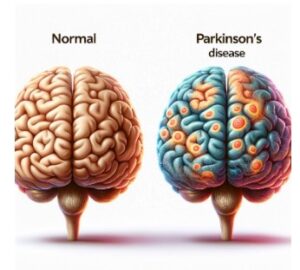What is Parkinson’s Disease: A Comprehensive Guide to Symptoms, Treatments, & the Parkinson’s Plan

Understanding what is Parkinson’s Disease: An Introduction
What is Parkinson’s disease? Parkinson’s is a progressive neurological disorder that affects movement, causing a range of symptoms that can significantly impact daily life. Understanding this condition, its symptoms, and available treatments is crucial for those affected and their loved ones. In this comprehensive guide, we’ll explore Parkinson’s disease in-depth and introduce The Parkinson’s Plan, a unique integrative approach to managing this condition. This disease not only challenges the physical capabilities of those it affects but also poses significant emotional and psychological hurdles. As the population ages, the prevalence of Parkinson’s disease is increasing, making it more important than ever to understand and address this condition effectively. The journey through Parkinson’s is unique for each individual, with symptoms and progression varying widely. This variability necessitates a deep understanding and a personalized approach to treatment and care. In this blog, we aim to demystify Parkinson’s disease, providing valuable insights into its nature, the challenges it presents, and the latest advancements in treatment. Our goal is to empower patients, caregivers, and healthcare professionals with knowledge and resources to tackle this condition head-on.Exploring Parkinson’s Disease: Definitions and Causes
Parkinson’s disease is a neurodegenerative disorder that primarily affects dopamine-producing neurons in a specific area of the brain called the substantia nigra. As these neurons deteriorate, dopamine levels decrease, leading to the symptoms commonly associated with Parkinson’s. This condition is more than just a movement disorder; it encompasses a wide range of physical and cognitive symptoms, making it a complex ailment to understand and treat. The exact cause of what is Parkinson’s disease remains largely unknown, though a combination of genetic and environmental factors is believed to play a role. The onset of Parkinson’s is typically gradual, often starting with a barely noticeable tremor in just one hand. However, while tremor may be the most well-known sign of Parkinson’s disease, the disorder also commonly causes stiffness or slowing of movement. Over time, Parkinson’s disease may affect both movement and speech, severely impacting the quality of life. Early diagnosis and intervention are key to managing the symptoms and improving patient outcomes. Understanding the intricacies of this disease is crucial for developing effective treatment strategies and supporting those who live with Parkinson’s every day.
Identifying Symptoms: How Parkinson’s Affects the Body
The symptoms of Parkinson’s disease are varied and can significantly impact different aspects of daily life. Here’s a more detailed look at each major symptom and its presentation:- Tremors
- Noticeable early sign, usually starting in a limb (hand or fingers).
- Characterized by a “pill-rolling” tremor of the thumb and forefinger.
- More prominent at rest and may decrease during movement.
- Can become severe and interfere with daily activities over time.
- Rigidity
- Muscle stiffness that can occur in any part of the body.
- Can limit range of motion and cause pain.
- May prevent arm swinging while walking or difficulty getting out of a chair.
- Affects facial muscles, leading to a lack of expression (“Parkinson’s mask”).
- Bradykinesia (Slowness of Movement)
- Slows movement, making simple tasks difficult and time-consuming.
- Results in shorter steps, difficulty getting out of chairs, and decreased unconscious movements.
- Includes a reduction in the ability to initiate movement.
- Postural Instability (Impaired Balance and Coordination)
- Leads to a stooped posture and a tendency to fall.
- Difficulty balancing or compensating for a change in position.
- More common in later stages and increases the risk of falls.
- Speech Changes
- May become soft, quick, slur, or hesitate before talking.
- Usual inflection and modulation might disappear, making the voice sound monotonous.
- Early speech therapy is important for addressing these changes.
- Writing Changes
-
- Trouble with writing, known as Micrographia, resulting in small and difficult-to-read writing.
- Writing becomes slow and laborious.
-
- Non-Motor Symptoms
- Include cognitive impairment, mood disorders (depression and anxiety), sleep disturbances, fatigue, constipation, and changes in blood pressure.
Treatments for Parkinson’s Disease
Treatment for Parkinson’s disease is multifaceted, involving medications, surgery, and lifestyle changes. Each Parkinson’s disease treatment options have their benefits and drawbacks, and what works best can vary from person to person.Medication’s for Parkinson’s Disease:
- Levodopa: The most effective Parkinson’s drug, Levodopa works by converting to dopamine in the brain.
- Positives: It significantly improves motor symptoms.
- Negatives: Long-term use can lead to fluctuations in its effectiveness and dyskinesia (involuntary movements).
- Benefits: It offers substantial improvement in quality of life, especially in early stages.
- Dopamine Agonists: These mimic dopamine effects in the brain but are less potent than Levodopa.
- Positives: They have a longer half-life than Levodopa and can be used in early stages.
- Negatives: Side effects can include sleepiness, hallucinations, and compulsive behaviors.
- Benefits: Useful in managing early symptoms and can be combined with Levodopa in advanced stages.
- MAO-B Inhibitors: These help prevent the breakdown of brain dopamine by inhibiting the enzyme monoamine oxidase.
- Positives: Can be used alone in early disease or with Levodopa in advanced stages.
- Negatives: Potential side effects include headache, indigestion, and high blood pressure.
- Benefits: They can provide symptom relief and are generally well-tolerated.
- Surgical Treatments:Deep Brain Stimulation (DBS): Involves implanting electrodes in specific parts of the brain.
- Positives: Effective for patients with advanced Parkinson’s who don’t respond to medications.
- Negatives: Involves risks like infection, stroke, and hardware complications.
- Benefits: Can significantly reduce symptoms and medication needs.
- Physical Therapy: Focuses on improving mobility, flexibility, and balance.
- Positives: Tailored to individual needs and can significantly improve daily functioning.
- Negatives: Requires ongoing commitment and may not be accessible to everyone.
- Benefits: Enhances mobility, reduces fall risk, and improves overall physical health.
- Occupational Therapy: Assists in maintaining independence in daily activities
- Positives: Helps adapt living spaces to needs and teaches strategies for daily tasks.
- Negatives: May be challenging to implement changes and adapt to new methods.
- Benefits: Promotes independence and safety in daily life.
- Speech Therapy: Addresses speech and swallowing difficulties.
- Positives: Improves communication abilities and swallowing safety.
- Negatives: Progress can be slow and requires regular practice.
- Benefits: Enhances quality of life through better communication and reduced risk of choking.
Guidance for Newly Diagnosed Patients: Starting Your Journey
If you or a loved one has been recently diagnosed and is researching what is Parkinson’s disease and how to manage it, it’s important to understand that while there is currently no cure, there are many effective ways to manage symptoms and maintain quality of life. Treatment plans are highly individualized, based on specific symptoms, overall health, and personal preferences. It’s crucial to work closely with a healthcare team that understands Parkinson’s and to be proactive in managing the disease. Lifestyle changes, such as regular exercise, a healthy diet, and stress management, can also play a significant role in managing Parkinson’s disease.
The Parkinson’s Plan: A Comprehensive Care Approach
An Integrative Approach of The Parkinson’s Plan offers a unique approach to managing Parkinson’s disease. Their integrative care model combines traditional treatments with holistic methods, focusing on the individual needs of each patient.-
-
- Amino Acid Protocol: This protocol potentially reverse symptoms and reduce common drug consequences.
- Healthy Digestion Program: Tailored for patients with digestive issues, a common concern in Parkinson’s.
- Environmental Detox Program: Aims to alleviate neurological toxicity, potentially contributing to Parkinson’s.
- Healthy Foundations Program: A holistic approach addressing the whole body’s health.
-
Choosing The Parkinson’s Plan: Benefits and Support
The Parkinson’s Plan stands out for several reasons: Choosing The Parkinson’s Plan for managing Parkinson’s disease is a decision that can significantly impact a patient’s life. Here’s why this approach stands out:- Personalized Care: The Parkinson’s Plan understands that each case of Parkinson’s is unique. Their treatment plans are highly personalized, considering the individual’s symptoms, lifestyle, and overall health. This bespoke approach ensures that each patient receives the most effective and appropriate care for their specific situation.
- Comprehensive Approach: Unlike conventional treatments that often focus solely on symptom management, The Parkinson’s Plan adopts a comprehensive approach. They address not just the neurological symptoms but also the overall health and well-being of the patient. This holistic view is crucial in managing a complex condition like Parkinson’s, where symptoms can affect every aspect of life.
- Integrative Therapies: The Parkinson’s Plan combines the best of conventional medicine with alternative therapies. This integration allows for a more rounded treatment, tackling the disease from multiple angles. It opens up avenues for relief and improvement that might not be available through traditional methods alone.
- Enhanced Quality of Life: The ultimate goal of The Parkinson’s Plan is not just to manage the symptoms of Parkinson’s but to enhance the quality of life of those living with the disease. By addressing physical, mental, and emotional health, they help patients lead fuller, more active lives despite their diagnosis.
- Empowering Patients: The Parkinson’s Plan is about empowering patients. They provide education and support, enabling patients to take an active role in managing their condition. This empowerment is key to living well with Parkinson’s, as it fosters a sense of control and positivity.
- Community and Support: Patients at The Parkinson’s Plan are not just receiving treatment; they are part of a community. This sense of belonging and support from others who understand the journey with Parkinson’s is invaluable.
- Ongoing Research and Innovation: The Parkinson’s Plan is committed to staying at the forefront of Parkinson’s research and treatment. This commitment means patients benefit from the latest advancements and innovative approaches in the field of Parkinson’s care.
- Personalized Care: Each treatment plan is tailored to the individual’s unique symptoms and health status.
- Comprehensive Approach: Addresses not just neurological symptoms but overall health and well-being.
- Integrative Therapies: Combines conventional and alternative therapies for a more holistic treatment.
Concluding Thoughts: Empowering Patients with Knowledge and Care
Parkinson’s disease, while challenging, can be managed effectively with the right combination of treatments. The Parkinson’s Plan offers a comprehensive and integrative approach, providing hope and improved quality of life for those living with Parkinson’s. By understanding the disease, its symptoms, and the various treatment options available, patients and their families can make informed decisions about their care.For more information and Resources, please visit the helpful links below:
| Category | Resource | Description |
|---|---|---|
| General Information | National Institute on Aging | Complete insights into Parkinson’s disease, covering causes, symptoms, and research findings. Visit Site |
| American Parkinson Disease Association | A resource hub offering support, education, and research information for Parkinson’s disease. Visit Site | |
| Michael J. Fox Foundation for Parkinson’s Research | Dedicated to finding a cure for Parkinson’s disease through an aggressively funded research agenda. Visit Site | |
| Parkinson’s Foundation | Provides a broad spectrum of information, including understanding Parkinson’s, living well, and how to get involved. Visit Site | |
| Symptoms | Tremors | Involuntary shaking affecting different parts of the body. Visit Site |
| Rigidity | Muscle stiffness that impedes movement. Visit Site | |
| Bradykinesia | Slowness of movement, a hallmark symptom of Parkinson’s. Visit Site | |
| Postural Instability | Balance problems and difficulties with walking. Visit Site | |
| Speech Changes | Alterations in voice tone, clarity, and fluency. Visit Site | |
| Writing Changes | Difficulty in writing, including smaller, cramped handwriting. Visit Site | |
| Non-Motor Symptoms | Includes sleep disturbances, mood changes, and cognitive alterations. Visit Site | |
| Treatment Options | Levodopa | The most effective drug for controlling symptoms, often used in combination with carbidopa. Visit Site |
| Dopamine Agonists | Mimics dopamine in the brain to manage symptoms. Visit Site | |
| MAO-B Inhibitors | Helps prevent the breakdown of brain dopamine. Visit Site | |
| Deep Brain Stimulation (DBS) | A surgical treatment option for managing Parkinson’s symptoms. Visit Site | |
| Physical Therapy | Tailored exercises to improve mobility, flexibility, and balance. Visit Site | |
| Occupational Therapy | Strategies to maintain independence in daily activities. Visit Site | |
| Speech Therapy | Techniques to address speech and swallowing difficulties. Visit Site |

Sign Up For Our Newsletter
Sign up for more information on Parkinson’s disease treatment.